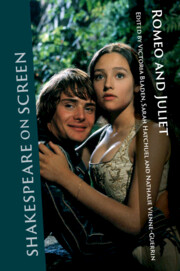Book contents
- Shakespeare on Screen: Romeo and Juliet
- Series page
- Shakespeare on Screen: Romeo and Juliet
- Copyright page
- Dedication
- Contents
- Figures
- Notes on Contributors
- Series Editors’ Preface
- Acknowledgements
- Chapter 1 Introduction – From Canon to Queer: Romeo and Juliet on Screen
- Part I Revisiting the Canon
- Chapter 2 The Italian Job: Franco Zeffirelli’s Romeo and Juliet and the 1960s
- Chapter 3 The Anguish of Youth in Film Adaptations of Romeo and Juliet
- Chapter 4 Aquatic and Celestial Space in Baz Luhrmann’s William Shakespeare’s Romeo + Juliet (1996)
- Chapter 5 Coming to Grips with Shakespeare’s Tragedy in a Film Musical: Re-assessing Robert Wise and Jerome Robbins’s West Side Story (1961)
- Part II Extending Genre
- Part III Serial and Queer Romeo and Juliets
- Index
- References
Chapter 3 - The Anguish of Youth in Film Adaptations of Romeo and Juliet
from Part I - Revisiting the Canon
Published online by Cambridge University Press: 10 October 2023
- Shakespeare on Screen: Romeo and Juliet
- Series page
- Shakespeare on Screen: Romeo and Juliet
- Copyright page
- Dedication
- Contents
- Figures
- Notes on Contributors
- Series Editors’ Preface
- Acknowledgements
- Chapter 1 Introduction – From Canon to Queer: Romeo and Juliet on Screen
- Part I Revisiting the Canon
- Chapter 2 The Italian Job: Franco Zeffirelli’s Romeo and Juliet and the 1960s
- Chapter 3 The Anguish of Youth in Film Adaptations of Romeo and Juliet
- Chapter 4 Aquatic and Celestial Space in Baz Luhrmann’s William Shakespeare’s Romeo + Juliet (1996)
- Chapter 5 Coming to Grips with Shakespeare’s Tragedy in a Film Musical: Re-assessing Robert Wise and Jerome Robbins’s West Side Story (1961)
- Part II Extending Genre
- Part III Serial and Queer Romeo and Juliets
- Index
- References
Summary
Of Shakespeare’s plays, none is so commonly adapted and appropriated in forms targeted towards youth audiences as Romeo and Juliet. This chapter considers three film adaptations of Romeo and Juliet through the lens of each film’s engagement with youth, and through their use of setting, props, performance and cinematography to affect, and thereby, emphasize the anguish of (and in) youth. It will be argued that each film’s means of affecting anguish requires a connection to youth as a privileged time of allowable indulgence. Anguish emerges as simultaneously pleasurable in its existential engagement, and painful in its tragic realism, and the effect is a privileging of anguish over the catharsis that conventionally concludes tragedy, leaving anguish and youth sustained indefinitely.
- Type
- Chapter
- Information
- Shakespeare on Screen: Romeo and Juliet , pp. 48 - 61Publisher: Cambridge University PressPrint publication year: 2023

